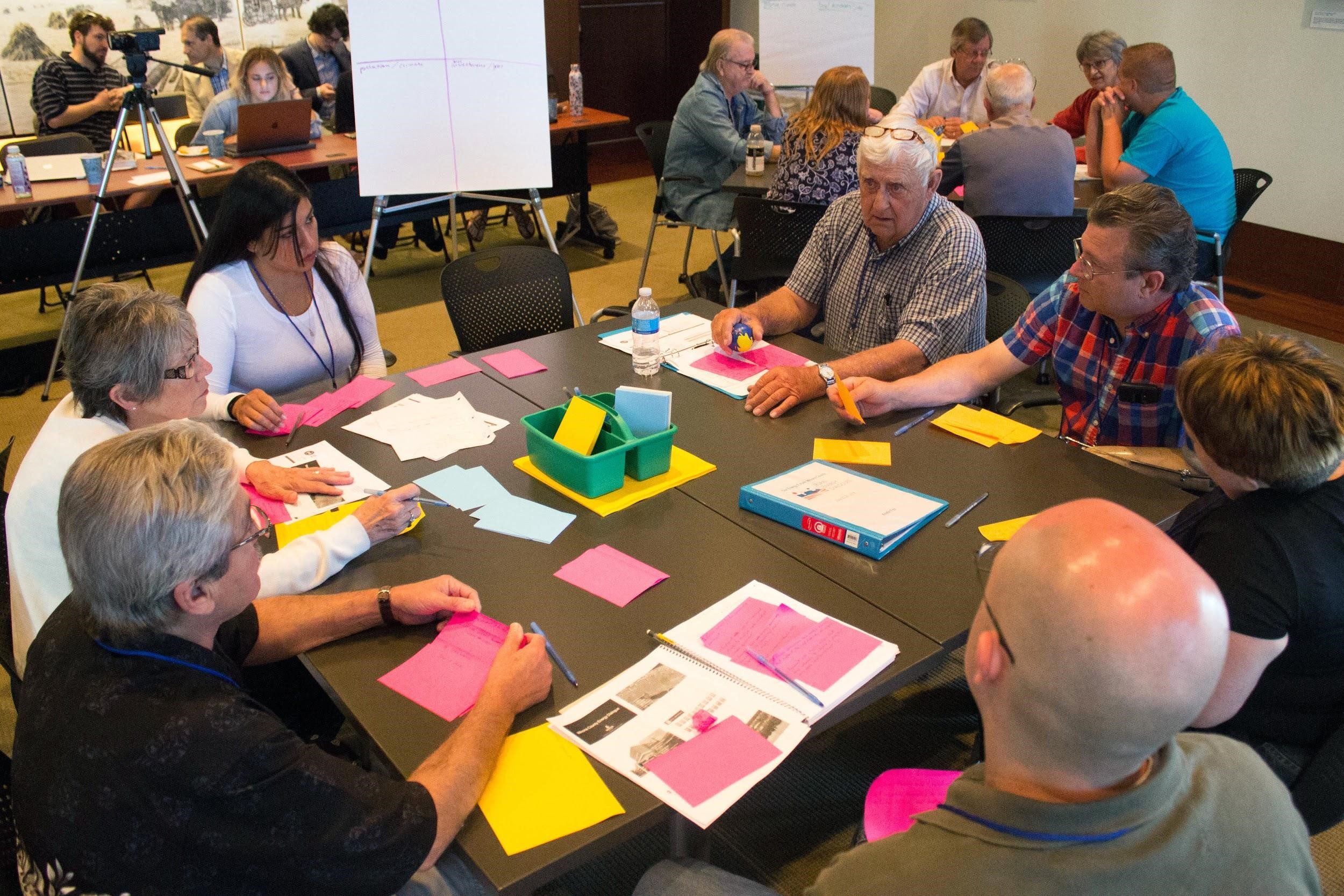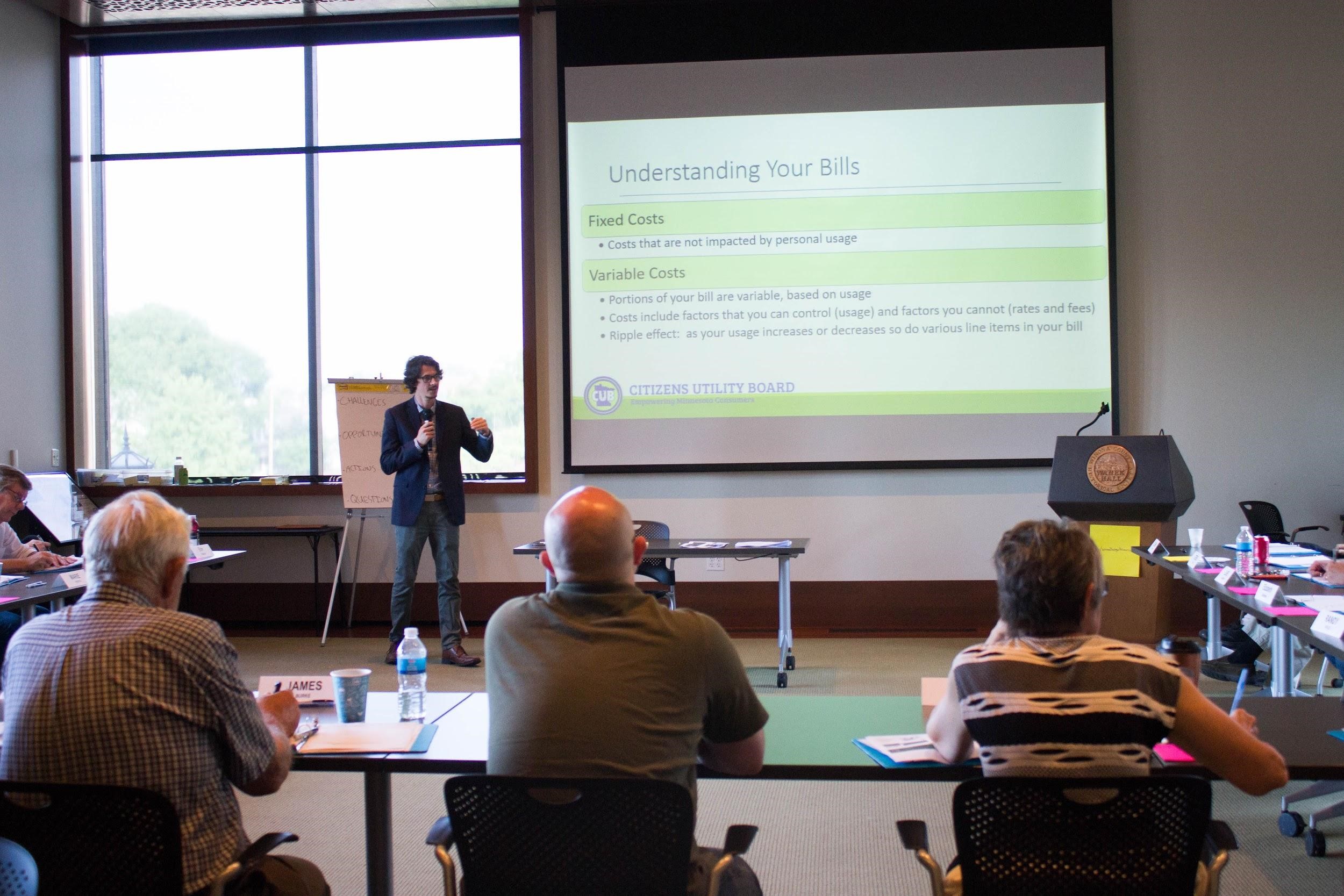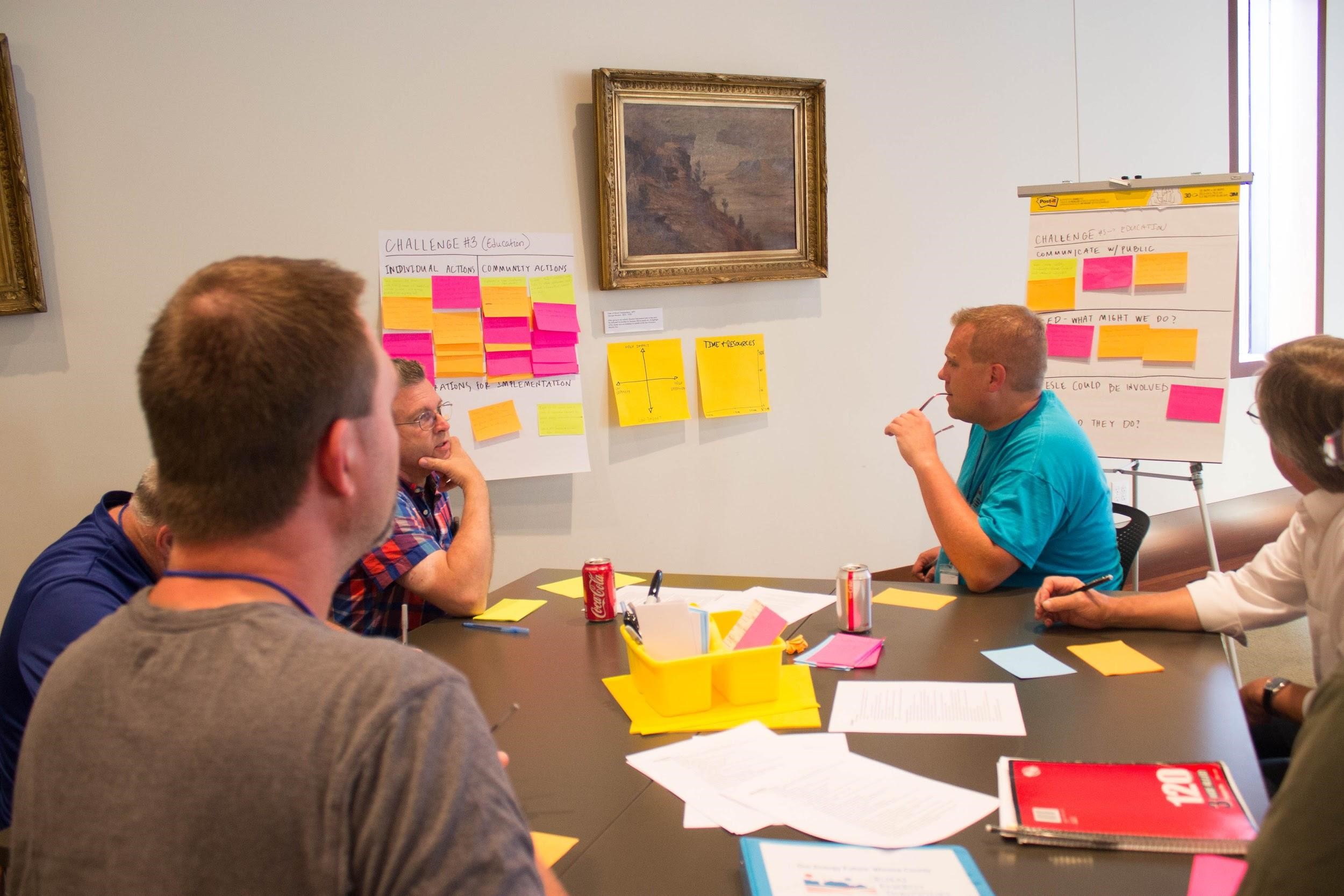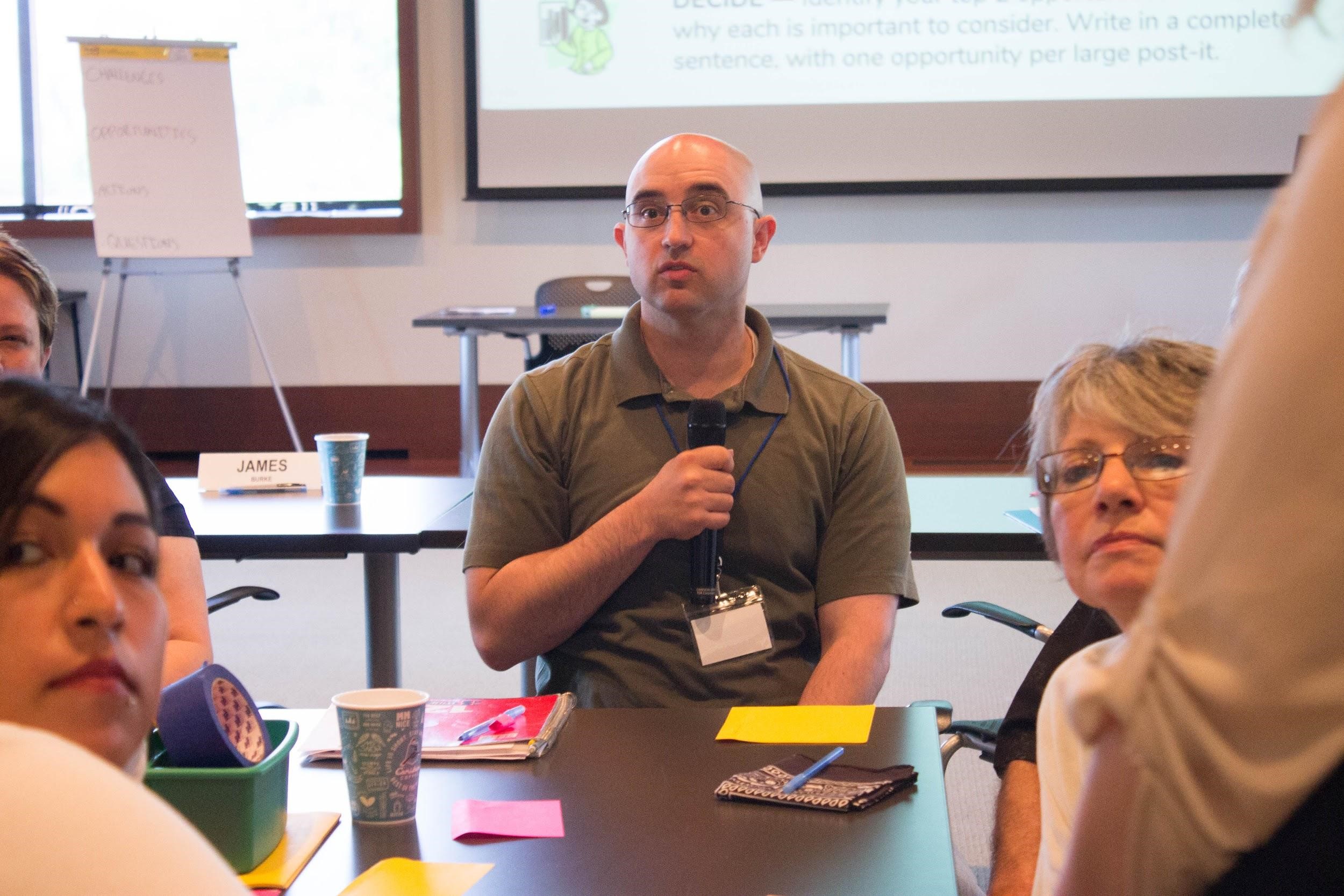When people have access to affordable, reliable and efficient energy, the entire community benefits. Everyone can worry a little bit less about outsized utility bills or energy outages, especially during the hottest and coldest months of the year or when severe weather strikes. In Winona County, Minnesota, the community has been busy creating a dependable local energy system that works for everyone. This past June, their commitment was reinforced at the Winona County Energy Dialogue.
Over the course of two days, a group of 19 Winona County residents met to learn more about how their energy system works, to create action plans to address energy-related challenges and to seize unique local opportunities. Of these participants, 13 were randomly selected to represent the demographic makeup of the area, while six were local officials and others involved in energy issues.
This dialogue follows in the footsteps of the Winona County Climate Dialogue hosted by the Jefferson Center and the Institute for Agriculture and Trade Policy in 2016. A different group of community members learned more about extreme weather and climate change, and identified how their community could adapt while remaining resilient and vibrant. Two key recommendations the group established were to pursue local renewable energy and to boost energy efficiency projects to guarantee affordable energy for all. The Energy Dialogue in 2018 dove deeper into these opportunities, and residents had the chance to consider local energy infrastructure, jobs, educational initiatives and more.

Evaluating Key Energy Criteria
To start the weekend, participants worked together in small groups to evaluate criteria of a productive local energy system. Keeping these in mind would help the group evaluate key energy stats, trends and background information to follow. Here’s why they thought the following criteria are needed in determining the future of energy in the community:
- Reliability: The energy system needs to consistently meet demands of consumers, especially during extreme events like storms.
- Affordability: Consumers need to be able to afford enough energy to meet their needs and be successful.
- Minimizing pollution and/or climate change: The energy system impacts pollution and climate change.
- Supporting local jobs and local investment: The energy system can support local economic activity.

A Local Energy 101
To bolster their understanding of energy basics, Lissa Pawlisch, from the Clean Energy Resource Teams (CERTs), spoke about energy trends and efficiency programs across the state. She stressed the difference between efficiency and conservation: Energy conservation is a practice, like turning off the lights, while efficiency refers to the tools we use to achieve it, like installing LED light bulbs. She also discussed available energy efficiency incentives and rebates, and showed how jobs have been increasing in the Minnesota renewables sector. Here are a few energy trends participants found most interesting:
- Residential electricity prices have increased by 85 percent since 2001.
- Minnesota currently gets 70 percent of its energy from imported fossil fuels.
- Solar, wind and other renewable options are rising in popularity and availability across the state.
Next up was Eli Massey from Midcontinent Independent System Operator (MISO), who spoke about energy sources and delivery. We don’t always consider how our energy actually gets to our homes, and the journey it takes from the source to our homes. He walked the group through the production of energy, the transmission of energy, and how it gets delivered to residents and businesses.
Rounding out the first day was a panel of local utility officials including Nathan Franklin (Dairyland Power Cooperative), Kyle Karger (City of Saint Charles) and Ross Lexvold (Xcel Energy) to explore local utilities and their decision-making. They presented a unique perspective of both urban and rural challenges, and discussed the opportunities for local utilities in the near future, such as battery technology, renewables, and R&D for bioenergy.
The next morning, Ben Bratrud from the Citizens Utility Board of Minnesota spoke about the impacts of the energy system on household energy consumers. Jim Goblirsch, of Winona State University, discussed the flip-side of the impacts of the energy system on business and industry consumers.

Identifying Unique Local Challenges and Opportunities
Keeping all of this information in mind, and using their shared criteria, participants once again broke up into small groups and identified local energy challenges. Here’s a summary (you can see all the challenges in the final report):
- Improving local infrastructure, taking advantage of new technology and preparing for security and distribution issues can take time and resources to adapt to different-sized utilities.
- Providing services at affordable costs can be challenging, because the cheapest energy may not comply with emissions standards.
- Educational initiatives about energy are currently lacking, and should include more information about energy efficiency programs, how to read bills and staying up to date with building standards.
On the other hand, they also identified exciting local energy opportunities. To recap:
- Supporting local energy infrastructure could mean new jobs for local works.
- Embracing new energy technology, in order to diversify energy sources, could make local energy more affordable overall.
- Educating and involving the community in energy decisions, including children and policymakers, could help the community make more informed decisions, improve consumption habits and boost understanding of where energy comes from.
One participant noted that these discussions provided a lot of opportunities to say, “Gee, I never would have thought about that.” To address challenges and opportunities, participants created action plans that included steps individuals and the community as a whole could take, ways to communicate the information, and others who could be involved in next steps. You can read all their plans for action here.

A Statement to Their Neighbors
Nearing the end of the dialogue, participants had time to reflect on their experiences and draft a statement to their neighbors about the event. Here’s a snapshot of what they wrote:
The Winona County Energy Dialogue featured a wide collection of opinions, perspectives, and great ideas from people from all walks of life and across the county. It was a productive conversation that helped bring shape to the major themes and concerns for Winona County’s present and future energy situation. We reviewed a lot of technical details and other information about our energy system in order to highlight the key information and recommendations in the report below. We can do more to conserve energy and use energy efficiently. We can research what’s trending our way, like new technology and renewable energy. And government is not the only solution to energy issues. All of us, as citizens or the private sector, can be involved.
What's Next for Energy in Winona County
This project offers unique opportunities for community members in Greater Minnesota to have a voice on the future of local energy, and to shape energy policy and action. At the end of the event, one attendee shared, “I’m not an expert, but I feel way more well-informed. I’m looking forward to staying in connection with people here, and having conversations with people outside this room.”
The Jefferson Center and the Institute for Agriculture and Trade Policy will continue working with local partners and energy leaders in Winona, Stevens, and Itasca County to identify resources and turn the community energy recommendations into action. In the words of a different participant, this provided residents with the unique chance to “keep moving forward and developing a context for what we need to do in the future.”
To follow the project, like the Rural Dialogues on Facebook and subscribe to our newsletter!
